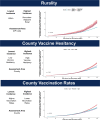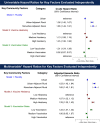Community risks for SARS-CoV-2 infection among fully vaccinated US adults by rurality: A retrospective cohort study from the National COVID Cohort Collaborative
- PMID: 36603014
- PMCID: PMC9815650
- DOI: 10.1371/journal.pone.0279968
Community risks for SARS-CoV-2 infection among fully vaccinated US adults by rurality: A retrospective cohort study from the National COVID Cohort Collaborative
Abstract
Background: While COVID-19 vaccines reduce adverse outcomes, post-vaccination SARS-CoV-2 infection remains problematic. We sought to identify community factors impacting risk for breakthrough infections (BTI) among fully vaccinated persons by rurality.
Methods: We conducted a retrospective cohort study of US adults sampled between January 1 and December 20, 2021, from the National COVID Cohort Collaborative (N3C). Using Kaplan-Meier and Cox-Proportional Hazards models adjusted for demographic differences and comorbid conditions, we assessed impact of rurality, county vaccine hesitancy, and county vaccination rates on risk of BTI over 180 days following two mRNA COVID-19 vaccinations between January 1 and September 21, 2021. Additionally, Cox Proportional Hazards models assessed the risk of infection among adults without documented vaccinations. We secondarily assessed the odds of hospitalization and adverse COVID-19 events based on vaccination status using multivariable logistic regression during the study period.
Results: Our study population included 566,128 vaccinated and 1,724,546 adults without documented vaccination. Among vaccinated persons, rurality was associated with an increased risk of BTI (adjusted hazard ratio [aHR] 1.53, 95% confidence interval [CI] 1.42-1.64, for urban-adjacent rural and 1.65, 1.42-1.91, for nonurban-adjacent rural) compared to urban dwellers. Compared to low vaccine-hesitant counties, higher risks of BTI were associated with medium (1.07, 1.02-1.12) and high (1.33, 1.23-1.43) vaccine-hesitant counties. Compared to counties with high vaccination rates, a higher risk of BTI was associated with dwelling in counties with low vaccination rates (1.34, 1.27-1.43) but not medium vaccination rates (1.00, 0.95-1.07). Community factors were also associated with higher odds of SARS-CoV-2 infection among persons without a documented vaccination. Vaccinated persons with SARS-CoV-2 infection during the study period had significantly lower odds of hospitalization and adverse events across all geographic areas and community exposures.
Conclusions: Our findings suggest that community factors are associated with an increased risk of BTI, particularly in rural areas and counties with high vaccine hesitancy. Communities, such as those in rural and disproportionately vaccine hesitant areas, and certain groups at high risk for adverse breakthrough events, including immunosuppressed/compromised persons, should continue to receive public health focus, targeted interventions, and consistent guidance to help manage community spread as vaccination protection wanes.
Copyright: © 2023 Anzalone et al. This is an open access article distributed under the terms of the Creative Commons Attribution License, which permits unrestricted use, distribution, and reproduction in any medium, provided the original author and source are credited.
Conflict of interest statement
The authors have declared that no competing interests exist.
Figures





Similar articles
-
Associations between COVID-19 therapies and outcomes in rural and urban America: A multisite, temporal analysis from the Alpha to Omicron SARS-CoV-2 variants.J Rural Health. 2025 Jan;41(1):e12857. doi: 10.1111/jrh.12857. Epub 2024 Jul 2. J Rural Health. 2025. PMID: 38953158 Free PMC article.
-
Association Between Immune Dysfunction and COVID-19 Breakthrough Infection After SARS-CoV-2 Vaccination in the US.JAMA Intern Med. 2022 Feb 1;182(2):153-162. doi: 10.1001/jamainternmed.2021.7024. JAMA Intern Med. 2022. PMID: 34962505 Free PMC article.
-
Long-Term Mortality Following SARS-CoV-2 Infection in Rural Versus Urban Dwellers With Autoimmune or Inflammatory Rheumatic Disease: A Retrospective Cohort Analysis From the National COVID Cohort Collaborative.Arthritis Care Res (Hoboken). 2025 Jan;77(1):143-155. doi: 10.1002/acr.25421. Epub 2024 Oct 16. Arthritis Care Res (Hoboken). 2025. PMID: 39158165
-
Cannabis use, abuse and dependence during the COVID-19 pandemic: a scoping review.J Neural Transm (Vienna). 2023 Jan;130(1):7-18. doi: 10.1007/s00702-022-02564-8. Epub 2022 Nov 8. J Neural Transm (Vienna). 2023. PMID: 36346483 Free PMC article.
-
Role of imaging in rare COVID-19 vaccine multiorgan complications.Insights Imaging. 2022 Mar 14;13(1):44. doi: 10.1186/s13244-022-01176-w. Insights Imaging. 2022. PMID: 35286509 Free PMC article. Review.
Cited by
-
Associations between COVID-19 therapies and outcomes in rural and urban America: A multisite, temporal analysis from the Alpha to Omicron SARS-CoV-2 variants.J Rural Health. 2025 Jan;41(1):e12857. doi: 10.1111/jrh.12857. Epub 2024 Jul 2. J Rural Health. 2025. PMID: 38953158 Free PMC article.
-
Going Forward: Potential Impact of Protein-Based COVID-19 Vaccination Coverage on Population Outcomes and Costs in the United States.Vaccines (Basel). 2024 Jan 12;12(1):74. doi: 10.3390/vaccines12010074. Vaccines (Basel). 2024. PMID: 38250887 Free PMC article.
-
Seroprevalence and silent infection rate during SARS-CoV-2 pandemic among children and adolescents in Western Pomerania: a multicenter, cross-sectional study-the COVIDKID study.PeerJ. 2024 Nov 11;12:e18384. doi: 10.7717/peerj.18384. eCollection 2024. PeerJ. 2024. PMID: 39544417 Free PMC article.
-
Accelerating a learning public health system: Opportunities, obstacles, and a call to action.Learn Health Syst. 2024 Sep 30;8(4):e10449. doi: 10.1002/lrh2.10449. eCollection 2024 Oct. Learn Health Syst. 2024. PMID: 39444503 Free PMC article.
-
COVID-19 Testing Behavior as a Predictor of COVID-19 Vaccination in Southeastern Louisiana: A Longitudinal Cohort Study.Vaccines (Basel). 2024 Nov 27;12(12):1338. doi: 10.3390/vaccines12121338. Vaccines (Basel). 2024. PMID: 39772000 Free PMC article.
References
-
- COVID data tracker: monitoring variant proportions: Centers for Disease Control and Prevention; 2021. Available from: https://covid.cdc.gov/covid-data-tracker/#variantproportions.
-
- Abu-Raddad LJ, Chemaitelly H, Ayoub HH, Yassine HM, Benslimane FM, Al Khatib HA, et al.. Association of Prior SARS-CoV-2 Infection With Risk of Breakthrough Infection Following mRNA Vaccination in Qatar. Jama. 2021;326(19):1930–9. doi: 10.1001/jama.2021.19623 ; PubMed Central PMCID: PMC8561432. - DOI - PMC - PubMed
-
- Alishaq M, Nafady-Hego H, Jeremijenko A, Al Ajmi JA, Elgendy M, Vinoy S, et al.. Risk factors for breakthrough SARS-CoV-2 infection in vaccinated healthcare workers. PLoS One. 2021;16(10):e0258820. Epub 20211015. doi: 10.1371/journal.pone.0258820 ; PubMed Central PMCID: PMC8519462. - DOI - PMC - PubMed
-
- Singanayagam A, Hakki S, Dunning J, Madon KJ, Crone MA, Koycheva A, et al.. Community transmission and viral load kinetics of the SARS-CoV-2 delta (B.1.617.2) variant in vaccinated and unvaccinated individuals in the UK: a prospective, longitudinal, cohort study. The Lancet Infectious Diseases. 2022;22(2):183–95. doi: 10.1016/S1473-3099(21)00648-4 - DOI - PMC - PubMed
Publication types
MeSH terms
Substances
Grants and funding
LinkOut - more resources
Full Text Sources
Medical
Miscellaneous

